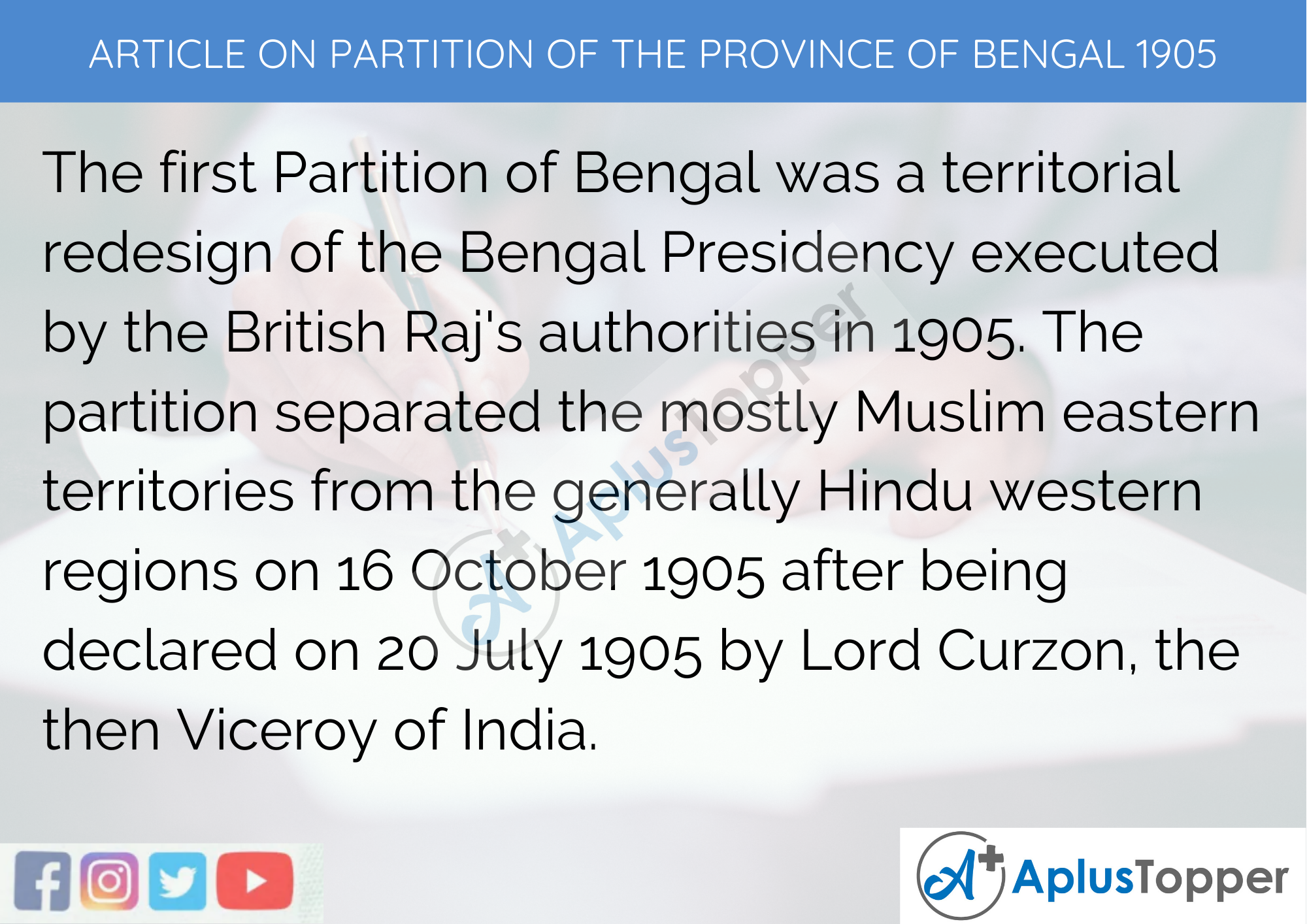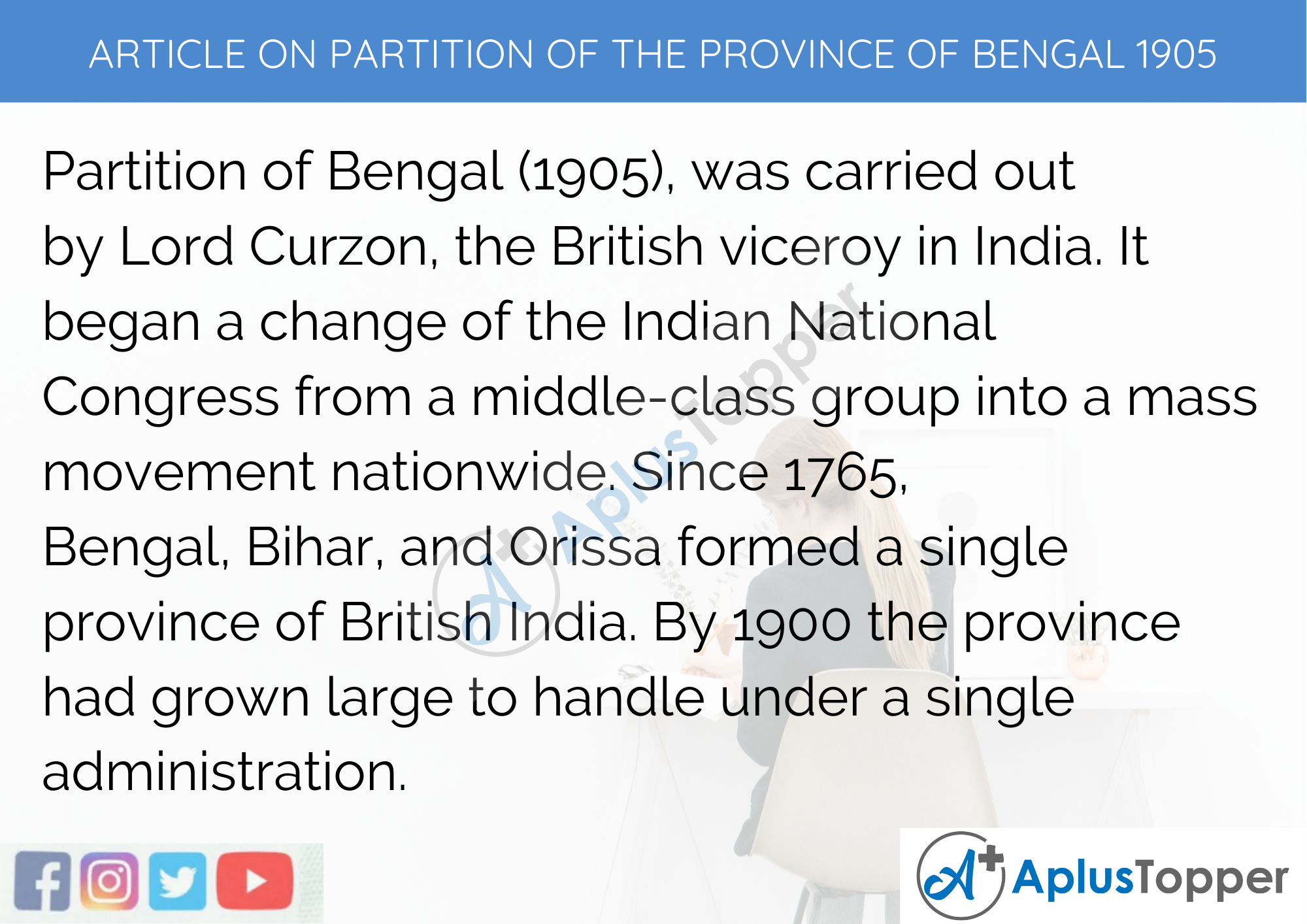Article On Partition of the Province of Bengal 1905: The decision of partition of India, specifically Bengal, was taken by the then Viceroy (1898 to 1911), Lord Curzon. The planning of reorganizing territories was strategic as it divided the western areas with most of the Hindu population from the western Muslim populated areas.
The decision was taken on July 20th of the year 1905; however, the implementation of the partition action took place on 16th October of the same year. Lord Curzon felt the increase in Bengal’s uprisings is because the state is too large for being governed efficiently. Therefore, the idea of India’s partition centered on administrative reasons as the British Government concentrated on the ideology of divide and rule.
You can read more Article Writing about people, sports, technology many more.
Long And Short Articles On Partition Of The Province Of Bengal 1905 for Students and Children in English
Partition of the Province of Bengal 1905 is an essential part of the history of the partition of Bengal, which should be known by every Indian citizen. Students who go to schools and colleges can get asked to write articles on the subject for their assignments and exams. The long Article on Partition of the Province of Bengal 1905 are useful to people studying in classes 7, 8, 9, and 10. On the other hand, the short Article on Partition of the Province of Bengal 1905 are standard among students of classes 1, 2, 3, 4, 5, and 6.

Long Article On Partition of the Province of Bengal 1905 In English 500 Words
The British Government authorized the first territorial redesigning of the Bengal Presidency during their reign in 1905. This first partition of Bengal execution aimed to divide the heavily Hindu populated western area to the Muslim populated eastern zone. The declaration of partition was made in July of 1905 by Lord Curzon, the then Viceroy of India, and later taken into action on the 16th day of October in the year 1905.
The wicked strategy of ruling on the divided nation astonished the people belonging to the Hindu community of West Bengal. Since the Bengal Presidency constructed by the British, the Hindus of Bengal would become a minority; therefore, they started rebelling.
The smart strategy that British Raj adopted to appease the Bengal sentiment, Lord Hardinge, in 1911 brought together Bengal. British Government did this to decrease or put an end to the Swadeshi movement riots, that protested against the arrangement and the developing beliefs among Hindus that East Bengal would have its court and approaches.
The Bengal Presidency was the most significant region in India under the British rule, with a population size of 78.5 million. That area constructed of Bengal, Bihar, Orissa, Assam, and portions of Chhattisgarh. The large size of this region led the British to face several challenges in administrating and also caused the neglecting of the affluent areas of the eastern sector.
The strategy that Curzon was initially aiming for was to divide Orissa, Bihar, and join fifteen eastern regions of Bengal with Assam. The east territory held a population of around thirty million, among which a significant portion consisted of Muslims, with the center at Dhaka.
After the partition, Curzon made sure to the point that the new province was thought of for the Muslims but also contradicted by saying that the administration aimed to divide Bengali’s or rather the vast region. The Western areas shaped the other part with Orissa and Bihar. The association of western Bengal with Orissa and Bihar reduced the speakers of the Bengali language to a minority. Muslims drove by the Nawab Sallimullah of Dhaka supported the partition, and Hindus opposed it.
Bengal’s middle class considered this to be the destruction of their dear country just as a strategy to lessen their authority. The Congress arranged gatherings where petitions against the partition were gathered and given to impassive authorities. Surendranath Banerjee conceded that the petitions were inadequate and as the date for the partition moved nearer, stringent approaches started, like boycotting British goods. He liked to mark this move as “swadeshi” rather than boycott.
The parcel activated radical nationalism. Bengali Hindus were annoyed with their minority status in the new territory. They started a furious agitation, by the methods of bombings, shootings, and deaths.
In 1909, separate elections were set up for Muslims and Hindus. With separated electorates, different political networks created with their political plans.
In 1947, Bengal was divided exclusively on religious grounds for the second time, as a significant aspect of India’s Partition following India and Pakistan’s development. In 1955, East Bengal turned out to be East Pakistan, and in 1971 turned into the autonomous province of Bangladesh.
Short Article On Partition of the Province of Bengal 1905 in English 300 Words
In the year 1905, the partition of Bengal was carried out by Lord Curzon, one of the British Viceroys in India. It began a change of the Indian National Congress from a middle-class political party into a mass movement nationwide.
Since 1765, Bengal, Bihar, Orissa formed a single province of British India. By 1900 the area had become too large and overbearing to handle under a single administration. East Bengal had been ignored In favor of West Bengal regions and Bihar because of poor communication and isolation due to geographical reasons.
Lord Curzon chose one of many schemes for partitions. The chosen one was to unite Assam, a part of province until 1874, with East Bengal’s 15 districts and thus formed a new territory with a population of 31 million. The majority of people of the region belonged to the Muslim community, and the capital of it was Dacca (that is now called Dhaka).
Hindus residing in West Bengal, who controlled Bengal’s finance and services and village life, most complained about the action being taken and proposed that the Bengali nation be split in two, making them unity in a province including the whole of Bihar and Orissa.
The British Government proposed the partition in Bengal because the notion of nationalism was more developed than elsewhere. Complaints against the partition included mass meetings, rural discussions, and swadeshi movements to boycott foreign-produced British imported goods. However, the revolts couldn’t stop the partition from taking place in reality as the partition continued despite the opposition of the public.
In 1911, when the capital was changed from Calcutta (now Kolkata) to Delhi, East and West Bengal were again reunited. Other than that, Assam again gained the chief commissionership while Bihar and Orissa were separated to form a new province. This step taken by Lord Hardinge aimed to combine the Bengal sentiment with administrative convenience. But this action displeased the Muslim majority of East Bengal, who had been benefitted from this partition. The last partition of the West Bengal from the East, after that, took place in 1947, which faced tremendous violence.

10 Lines On Partition of the Province of Bengal 1905
- Lord Curzon had decided to split Bengal into two provinces.
- The plan was to join western Bengal with provinces of Orissa and Bihar and joining 15 eastern districts with Assam consisting of mostly Muslims and Dacca (now Dhaka) as its capital.
- The idea for Bengal’s partition was opposed by Henry John Stedman Cotton, Chief Commissioner of Assam.
- The partition was also believed to happen because the Hindus had a better economic status than the Muslims.
- East Bengal readily supported the Partition of Bengal.
- Massive movements was carried out in opposition of the partition
- Assassinations, boycotts, non-violent movements were carried out against the Governor of new Bengal province
- This partition led the Indian National Congress to commence the Swadeshi Movement.
- High demands for national education followed the partition.
- Swaraj (self-rule) became a motto to Indian nationalism post the partition.
FAQ’s on Article on Partition of the Province of Bengal 1905
Question 1.
Who suggested the partition of Bengal in 1905?
Answer:
Lord Curzon suggested the partition in Bengal.
Question 2.
Why was the partition suggested?
Answer:
The partition was suggested to give attention to the Eastern Bengal.
Question 3.
Which date did the first partition of Bengal occur?
Answer:
On 16th October 1905, the first partition of Bengal occurred.
Question 4.
Who was responsible for revoking Bengal Partition?
Answer:
Lord Hardinge, revoked the Bengal Partition.
